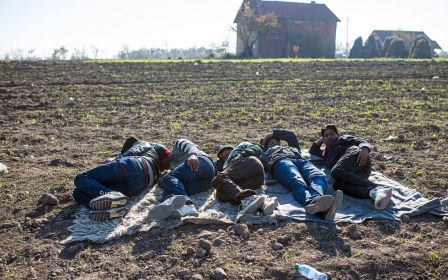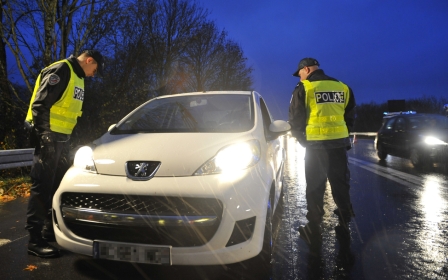Thousands trapped along Balkan route by new border closures

ZAGREB, Croatia - A refugee pile-up in the Balkans is looming after the route to central and northern Europe was closed to everyone but Syrian, Afghan and Iraqi asylum seekers.
On Wednesday night, Macedonia denied entry to hundreds of people including Pakistanis and Iranians, touching off a potentially catastrophic regional domino effect.
As Serbia, Croatia and Slovenia have followed suit, thousands of people now face the prospect of being trapped at different stages of the well-trodden Balkan route that has become one of the main highways into the heart of the European Union for refugees from Syria and elsewhere reaching southern Europe via Turkey and North Africa.
Asylum seekers from Syria, Afghanistan and Iraq must now provide identification at every border, as well as the paperwork they received when they were first registered in Greece, or other entry points to the European Union.
Anyone without the required documentation will be turned back. Compounding the problem, not all countries along the route share the same policy: Croatia will also allow Palestinians to enter, but the previous countries on the route won’t.
More than 650,000 people have made the journey from Greece to Macedonia, Serbia, Croatia and Slovenia.
Over the past months, each day at least 5,000 people have joined those streaming north towards Western Europe. The UN estimates 77 percent are from war-ravaged Syria, Iraq or Afghanistan. The rest are a kaleidoscope of nationalities weary of dictatorship, poverty, or insecurity.
Less than 24 hours before the lockdown began, Adasevci rest stop on the side of a Serbian highway 15km from Sid, a city near the Croatian border, was a chaotic sprawl of humanity on the move.
Worried-looking parents helped sleepy-eyed children brush their teeth at trickling water trucks, and a team of doctors bandaged a near-endless line of blistered feet. Harried aid workers and baton-toting police officers surveyed the melee as refugees waited for the buses that would take them on to Sid and Croatia.
'In Iran, they would kill me'
Shahab Rezai, 27, from Tehran, told Middle East Eye he was going to Germany. “Everything is good in Iran but the leader. Our president is not good,” he said. Theocratic rule, he said, was crippling: “Islam limits everything.”
Another young Iranian said he had “a secret reason” to flee to Europe. Away from the group, he opened up: “I am homosexual, and in Iran, they would kill me. I studied law in university, I know this is true.”
He was following in the recent footsteps of other gay friends before him, young men who saw a window of opportunity and took it. “I want to live my own life and be who I am,” he said.
Another gay friend was still in Tehran, delaying leaving his family, but the young lawyer in Adasevci said he wanted his friend to hurry, that he feared the chance might soon be gone. The following day, it was.
After a surge of refugees this summer, referred to by many volunteers along the Balkan route as “the first wave”, demographics shifted in September and October to include more women and children.
Aid workers along the route report a striking number of pregnant women making the journey, many of them in the late stages of pregnancy. When babies are born en route, families pause for a day or two and then continue their journey, babes in arms.
In recent weeks, there have also been more asylum seekers from further afield: Bangladeshis, Pakistanis, Eritreans and a growing number of Iranians.
In the western Balkans, a route widely perceived to be safer than the Bulgarian route, especially for women and children, this “second wave” consists of at least 5,000 people entering new countries each day.
'More families now'
Francesca Bonelli, a UNHCR aid worker at Adasevci, said she was seeing an increasing number of Bangladeshis, Moroccans and Tunisians. “At first there were many single men, but there are more families now,” she told MEE.
Anecdotally, volunteers and aid workers say the bulk of the second wave tends to be poorer and less informed about the journey and their options than the people who came in the months before.
“There is a public dream of life in Europe, and a lot of hopes that I am afraid will not be met,” said Bonelli.
In Belgrade, civil society organisations say they see cause and effect.
“When our state in some way legalised the illegal crossing of the borders, it was a call for them to come,” said Jelena Hrnjak, of the Atina anti-trafficking association in Belgrade, Serbia. She warned of a surge in wartime profiteering and a rise in the number of minors travelling alone, particularly Afghan boys.
Anti-immigrant and anti-refugee sentiment has been surging across Europe and the Balkans, spiking in the last week with the Islamic State group’s attacks on Paris, which killed at least 120 people.
While aid workers, refugees and activists emphasise that those people fleeing countries where wars no longer rage but human rights violations or corruption are rife are still legitimate asylum seekers, some officials disagree.
Speaking of those his government recognised as “pure economic migrants”, Slovenian police spokesman Drago Menegalia recently said, "These foreigners do not qualify for international protection.”
Macedonia’s plan to build a fence along its border with Greece will close one route to Europe, but experts say it won’t stop people from moving: if anything, they will take greater risks in the hope of reaching the safety they seek.
New MEE newsletter: Jerusalem Dispatch
Sign up to get the latest insights and analysis on Israel-Palestine, alongside Turkey Unpacked and other MEE newsletters
Middle East Eye delivers independent and unrivalled coverage and analysis of the Middle East, North Africa and beyond. To learn more about republishing this content and the associated fees, please fill out this form. More about MEE can be found here.




